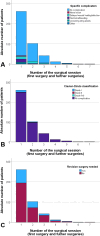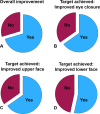Surgery for facial palsy in the hands of otorhinolaryngologists: a population-based study
- PMID: 39443389
- PMCID: PMC11805891
- DOI: 10.1007/s00405-024-09044-7
Surgery for facial palsy in the hands of otorhinolaryngologists: a population-based study
Abstract
Purpose: Modern facial surgery can improve eye closure and address facial functional and emotional expression disabilities in case of severe acute facial paralysis with low probability of recovery and in cases of chronic flaccid facial paralysis. Reports on outcome typically originate from specialized tertiary care centers, whereas population-based data from routine care beyond specialized centers is sparse.
Methods: Therefore, patients' characteristics, surgical techniques, postoperative complications, and patients' satisfaction with the final outcome were analyzed for all inpatients with facial paralysis undergoing facial surgery in Thuringia, a federal state in Germany, between 2006 and 2022. 260 patients (female 41.5%; median age 65 years) were included.
Results: On average, the surgery rate was higher for men than for women (0.83 ± 0.39 versus 0.58 ± 0.24 per 100,000 population per year). For first surgery, static procedures were dominating (67.3%), followed by dynamic reconstruction (13.8%), and combined static and dynamic reconstructions (13.5%). The most frequent type of surgery was upper lid weight loading (38.5%), hypoglossal-facial jump nerve suture (17.3%), and facial-facial interpositional graft suture (16.9%). Bleeding/hematoma formation needing revision surgery was the most frequent complication (6.2%). Overall, 70.4% of the patients were satisfied with the final result. The satisfaction was higher if the target was to improve eye closure (65.2%) or to improve upper face function (65.3%) than to improve the lower face function (53.3%).
Conclusions: If facial nerve reconstruction surgery and/or upper lid weight placement was performed, the satisfaction was significantly higher. If revision surgery was needed to improve the result, the satisfaction was significantly lower.
Keywords: Facial nerve; Facial palsy; Facial paralysis; Facial reanimation; Healthcare research; Reconstructive surgery.
© 2024. The Author(s).
Conflict of interest statement
Declarations. Conflict of interest: The authors declare no competing interests.
Figures



Similar articles
-
Neurorrhaphy for Facial Reanimation with Interpositional Graft: Outcome in 23 Patients and the Impact of Timing on the Outcome.World Neurosurg. 2019 Jun;126:e688-e693. doi: 10.1016/j.wneu.2019.02.124. Epub 2019 Mar 4. World Neurosurg. 2019. PMID: 30844532
-
Long-Term Facial Nerve Outcome in Primary Parotid Cancer Surgery: A Population-Based Analysis.Laryngoscope. 2021 Dec;131(12):2694-2700. doi: 10.1002/lary.29666. Epub 2021 May 29. Laryngoscope. 2021. PMID: 34050959
-
Reconstruction of complex peripheral facial nerve defects by a combined approach using facial nerve interpositional graft and hypoglossal-facial jump nerve suture.Laryngoscope. 2011 Nov;121(11):2402-5. doi: 10.1002/lary.22357. Laryngoscope. 2011. PMID: 22020891
-
A comprehensive approach to long-standing facial paralysis based on lengthening temporalis myoplasty.Acta Otorhinolaryngol Ital. 2012 Jun;32(3):145-53. Acta Otorhinolaryngol Ital. 2012. PMID: 22767978 Free PMC article. Review.
-
Free Gracilis Transfer and Static Facial Suspension for Midfacial Reanimation in Long-Standing Flaccid Facial Palsy.Otolaryngol Clin North Am. 2018 Dec;51(6):1129-1139. doi: 10.1016/j.otc.2018.07.009. Epub 2018 Aug 10. Otolaryngol Clin North Am. 2018. PMID: 30104040 Review.
Cited by
-
The synergistic role of viral infection and immune response in the pathogenesis of facial palsy.J Neurovirol. 2025 Jun;31(3):208-218. doi: 10.1007/s13365-025-01258-7. Epub 2025 May 15. J Neurovirol. 2025. PMID: 40374879 Free PMC article. Review.
References
-
- Urban E, Volk GF, Geissler K, Thielker J, Dittberner A, Klingner C et al (2020) Prognostic factors for the outcome of Bells’ palsy: A cohort register-based study. Clinical otolaryngology : official journal of ENT-UK ; official journal of Netherlands Society for Oto-Rhino-Laryngology & Cervico-Facial Surgery. 45(5):754–761. 10.1111/coa.13571 - PubMed
-
- Mueller B, Volk GF, Guntinas-Lichius O (2017) Rehabilitation of facial palsy and vertigo in patients with vestibular schwannoma. Hno 65(9):724–734. 10.1007/s00106-016-0125-y - PubMed
-
- Thielker J, Wahdan A, Buentzel J, Kaftan H, Boeger D, Mueller AH et al (2021) Long-term facial nerve outcome in primary parotid Cancer surgery: a Population-based analysis. Laryngoscope. 10.1002/lary.29666 - PubMed
-
- Dobel C, Miltner WH, Witte OW, Volk GF, Guntinas-Lichius O (2013) [Emotional impact of facial palsy]. Laryngo- rhino- otologie 92(1):9–23. 10.1055/s-0032-1327624 - PubMed
MeSH terms
LinkOut - more resources
Full Text Sources
Medical

